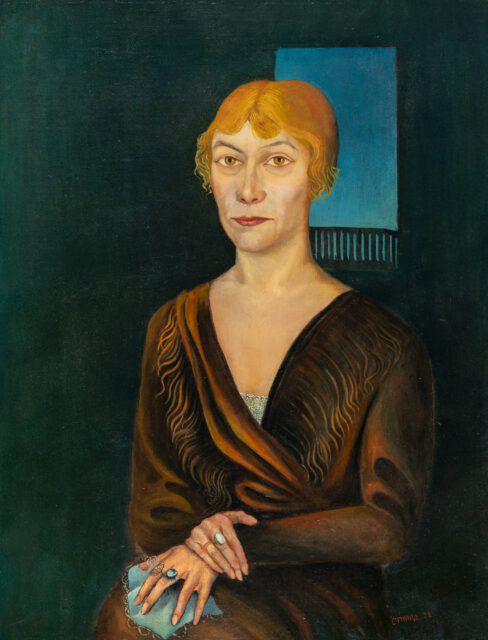Recto: Portrait of Lisa Matern – Verso: Portrait of Davringhausen
Details
With customs and shipping stamps on the reverse on the stretcher. Drenker-Nagels 55/56. Literature: Deutsche Kunst und Dekoration, vol. 50, 1922, p. 65 with ill.; of Waldegg, Joachim Heusinger, Leo Breuer und Heinrich Maria Davringhausen. Zwei rheinische Maler, in: Das Rheinische Landesmuseum Bonn 1977, issue 2, p. 33, with ill. 24.Exhibitions:Carlo Mense, Städtisches Kunstmuseum, Bonn 1961, Kat.- no. 5; Carlo Mense. Ölbilder, Graphik, Rathaus Charlottenburg, Berlin 1962, cat. no.10 (“Lisa”); “Nuova oggettività” tedesca (1918-1933), Galleria d’arte Stivani, Bologna 1972, ill. 14; Il Realismo in Germania/Réalisme en Allemagne 1918-1933, Rotonda di Via Besana, Milan/Musée d’Art et d’Industrie, St. Etienne 1972/1974, cat. no.77, with ill.; Die zwanziger Jahre im Porträt, Rheinisches Landesmuseum, Bonn 1976, cat. no.74, with ill.; Neue Sachlichkeit and German Realism of the Twenties, Hayward Gallery, London 1978/79, cat. no.183, with ill. Provenance: Galerie Neue Kunst Hans Goltz, Munich, 1922, gallery label with the title “Davringhausen” on the reverse; collection of Dr. Max Fischer (1886-1975), Stuttgart; Hauswedell & Nolte, Hamburg 7.6.1969, lot 911, with black and white ill.; Galleria del Levante, Munich/Milan 1972; private ownership, Italien; Lempertz, Cologne 31.5.2017, lot 390; private collection, Hessen.
Descrizione
• Carlo Mense was among the most important artists of Rhenish Expressionism and New Objectivity
• Static, sobre depiction of the sitter inkeeping with the style of New Objectivity
• The portrait on the reverse depicts Mense’s friend, the fellow painter Heinrich Maria Davringhausen
In keeping with the new style of “post-Expressionist” art in the years after the First World War, these two portraits by Carlo Mense are characterised by a sober and unsentimental style of depiction. In a deliberate departure from Expressionism, his highly precise painting style leaves the subjects static and as if frozen in a pose. Lisa Matern looks at the viewer with a serious and direct gaze. Dressed in dark clothes, she sits in an indefinable, dark room, only a window with a parapet is visible behind her head, where the sky glows in a dusky blue. The portrait is clearly reminiscent of Raphael’s “La Muta” due to the chosen framing and the pose. “Moreover, the similar composition and the precise elaboration of the piercing gaze (…) and, in particular, the somewhat staged interlacing of the hands with their ringed, delicate fingers are astonishing.” (Klara Drenker-Nagels, WVZ, p. 100). On the reverse of the canvas is a portrait of the Aachen painter Heinrich Maria Davringhausen at the easel, a close friend of Carlo Mense since his youth. This portrait was probably painted in around 1919. Carlo Mense was influenced early on by August Macke and quickly became involved in the avant-garde art scene in Cologne. He joined the Gereonsklub and the Cologne Secession. In 1912, he took part in the important Cologne Sonderbund exhibition and in 1913 in the exhibition of the “Rhenish Expressionists” in Bonn initiated by Macke and in Herwarth Walden’s First German Autumn Salon. Carlo Mense was well connected and was friends with numerous artist colleagues and gallery owners in the Rhineland, Berlin and Munich. After the caesura of the First World War, the Munich gallery Hans Goltz shows Mense’s first solo exhibition in 1918. In Munich at the beginning of the 1920s, Mense and his childhood friend and painter Heinrich Maria Davringhausen met Alexander Kanoldt and Richard Seewald and turned their attention to the emerging “post-Expressionist” painting movement. In 1925, they took part in the famous “New Objectivity” exhibition at the Kunsthalle Mannheim. In the same year, Mense and Kanoldt were appointed professors at the Breslau Academy. After its dissolution by the National Socialists in 1932, Mense moved to Italy for a while, before returning to Cologne in 1936. As part of the “Degenerate Art” campaign, Mense’s works were confiscated from museums and in the following years he adapted to the restrictive art policy with naive, romantic landscape motifs from his homeland. After the end of the war, Mense returned stylistically to his works of the 1910s and 1920s. In 1961, he was honoured with the Federal Cross of Merit.
* Tutte le informazioni includono la commissione a carico dell'acquirente (27%) senza IVA e senza garanzia. Salvo errori.
** Tutte le informazioni più la commissione a carico dell'acquirente e l'IVA e senza garanzia. Salvo errori.
*** Con riserva: L'offerta è stata accettata al di sotto del limite. L'acquisizione dell'opera potrebbe essere ancora possibile nella nostra vendita post-asta.
R = Le opere d'arte regolarmente tassate
N = Opere d'arte soggette a tassazione differenziata e provenienti da un paese non UE
Non è consentita la riproduzione e la distribuzione privata o commerciale di tutte le illustrazioni delle opere esposte nell'archivio della mostra e dell'asta. Tutti i diritti riservati.


